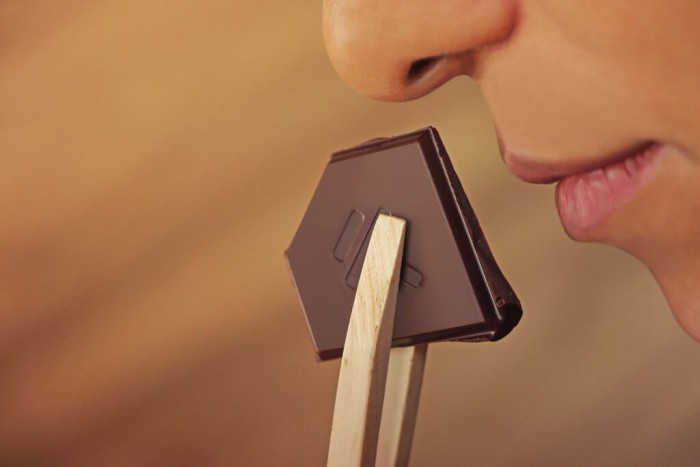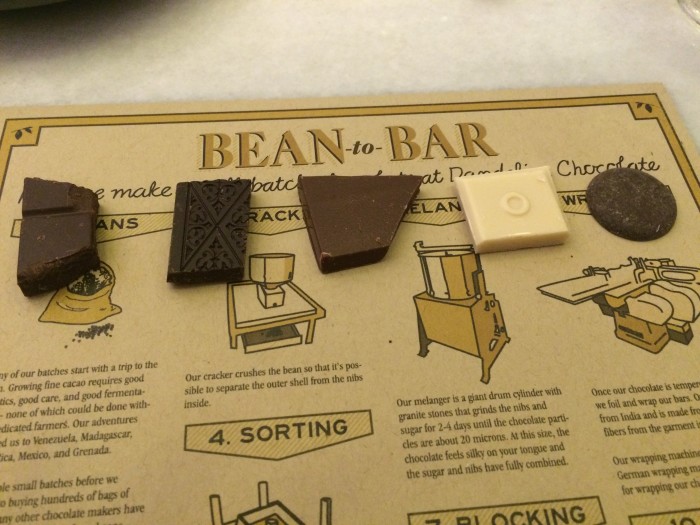How To Taste Chocolate Like You Know What You're Doing
Guys, chocolate is not for kids anymore. A good chocolate bar isn't candy, and it shouldn't be gobbled while your eyes glaze over from the glare of the TV. Despite all the recent chatter about self-indulgent $10 hipster chocolate bars, chocolate is actually one of the most affordable luxuries, in the same category as craft beer, specialty coffee and wine. Cacao even has terroir, for god's sake! Terroir!
American chocolate makers like Fruition, French Broad, and Patric focus on that terroir to bring out all the unique tastes of chocolate. That almost always means sweet, but what about earthy, fruity, floral? Have you ever thought about those flavors in chocolate?
In other words, don't be all Augustus Gloop about it. Slow down and savor the next chocolate bar you eat with these tips.
Wake and Taste
The best time to taste is in the morning, when your palate has had some beauty sleep. Scott Craig, the Dallas blogger who recently exposed the Mast Brothers for remelting chocolate, actually tweets about his "breakfast bar" every day.
Start with a plain old chocolate bar that doesn't include any add-ins like almonds, salt, or the like. Let your bar warm to room temperature before you even think about eating it, then break off one to three squares. (Side note: Common wisdom holds that chocolate should be kept in the fridge, but it does much better in a cool, dark place, like a cabinet.)
Take a Look
Chocolate isn't just brown. The color of the bar will tell you a lot about the way it tastes. First off, are there white patches? That could be bloom, when the fat separates from the cocoa, and indicates that the texture is probably altered. If there aren't any obvious defects, look more closely at the color. Chocolate from Ghana and Tanzania will be darker than chocolate from Madagascar, which is reddish. Some of the best cocoa beans in the world are white. (I know, mind blown!) This creates a lighter-colored chocolate. And if it's milk chocolate, it will, of course, be even lighter.
Stop and Smell the Chocolate
Who needs roses when you have cocoa beans and sugar? Smelling the chocolate instead of just popping it in your mouth will help you figure out how it's going to taste. Does it smell sweet? Like vanilla? Like burnt rubber? The chocolate won't always taste the way it smells, but the smells can reveal quite a lot about what's going on in that little brown bar.
There are a lot of theories about the best way to smell chocolate. In her book The Chocolate-Tasting Kit, author Eagranie Yuh advises tasters to "hold the chocolate between your thumb and index finger, cup your other hand around it like you're going to tell it a secret, bring it to your nose, and smell it."
The taste-testers on grocery chain Whole Foods' sensory panel place the chocolate on a plate or a piece of paper before smelling it. This is because any smells on your fingers might mask what's going on in the chocolate. For the same reason, To'ak Chocolate, whose bars retail for $260 and up, includes some handmade tweezers with its bars. All of these methods have the same result, though: "At chocolate judgings," says Clay Gordon, author of Discover Chocolate, "you see people walking around with brown smudges on their noses from smelling so much chocolate." Brings new meaning to the word "brownnoser."
Take a Bite
Some people chew the chocolate completely; others let it melt over a long period on their tongue. Both groups are somewhat correct. Myrna Fossum, who developed Whole Foods' sensory program, says to chew it once or twice, then stop. Close your eyes, let the chocolate melt on your tongue. See what you taste.
Raisins? Sure. Red berries? Often. Almond notes? You better believe it. You might not taste anything, just chocolate. Try comparing that one bar to other bars and then see if you notice a difference. Gordon recommends trying three at a time and comparing and contrasting pairs to determine your favorite of the group. He calls this a "tasting pyramid." It will also make it easier to pick out the specific flavors of each bar: One might be spicier than another or more earthy.
Don't pummel one chocolate into your mouth right after the other, though: Slow down and use a palate cleanser, like lemon water, plain crackers or slices of green apple.
When you get really good, like expert Ed Seguine, who has worked for Mars and Guittard and now owns his own company, you'll be able to taste different notes at the beginning, middle and end of a piece of chocolate, like wine's nose, body, and finish. This is more detectable in some chocolates than others, since some change as you eat them and others stay more constant.
Take Notes
The best tasters take vigilant notes, so they can remember what the heck they tasted the week before.
Take Time to Enjoy It, Too
Tasting is different from eating, and sometimes you just want to eat. Take a break from tasting with a chocolate that doesn't require you to think so deeply. For example, Gordon says his favorite chocolate to eat when he's not tasting or judging is "high-cocoa-content milk chocolate." That's right, milk chocolate. But the best chocolate bar is one that, depending on your mood, you can eat and enjoy or slow down and savor.
Megan Giller covers the world of American craft chocolate on her blog Chocolate Noise.



